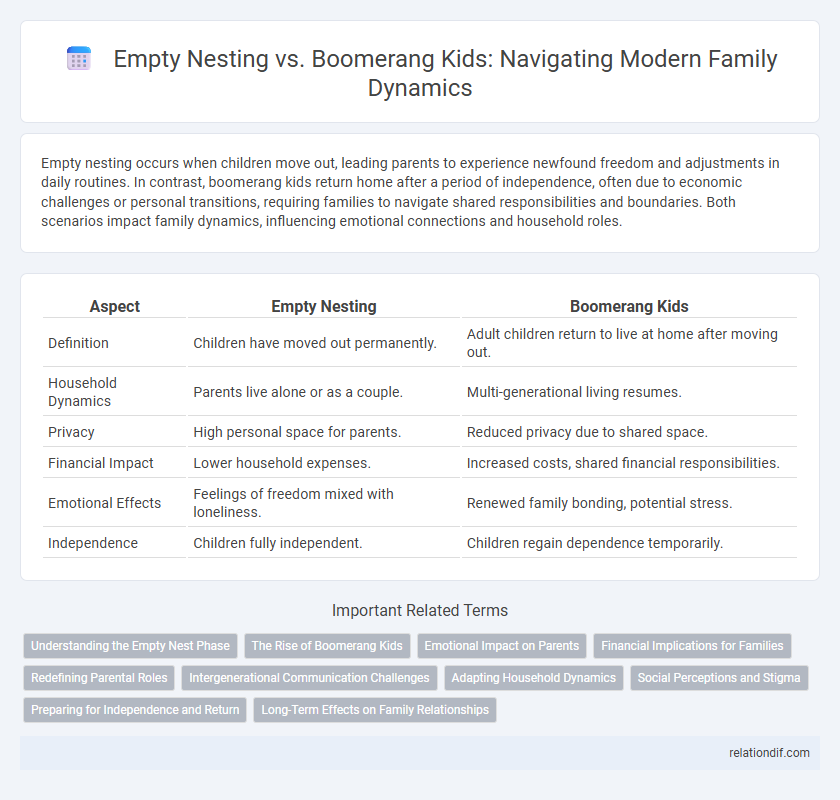Empty nesting occurs when children move out, leading parents to experience newfound freedom and adjustments in daily routines. In contrast, boomerang kids return home after a period of independence, often due to economic challenges or personal transitions, requiring families to navigate shared responsibilities and boundaries. Both scenarios impact family dynamics, influencing emotional connections and household roles.
Table of Comparison
| Aspect | Empty Nesting | Boomerang Kids |
|---|---|---|
| Definition | Children have moved out permanently. | Adult children return to live at home after moving out. |
| Household Dynamics | Parents live alone or as a couple. | Multi-generational living resumes. |
| Privacy | High personal space for parents. | Reduced privacy due to shared space. |
| Financial Impact | Lower household expenses. | Increased costs, shared financial responsibilities. |
| Emotional Effects | Feelings of freedom mixed with loneliness. | Renewed family bonding, potential stress. |
| Independence | Children fully independent. | Children regain dependence temporarily. |
Understanding the Empty Nest Phase
Empty nesting occurs when children leave home permanently, leading parents to adjust to an environment without daily caregiving responsibilities, often triggering mixed emotions and opportunities for personal growth. This phase involves redefining family dynamics and rediscovering individual identities as the household shifts from full to partial occupancy. Understanding the psychological impact and coping strategies is essential for parents to navigate the transition smoothly and maintain strong family bonds.
The Rise of Boomerang Kids
The rise of boomerang kids reflects a growing trend where adult children return to live with their parents after a period of independence, often due to economic challenges like student loan debt and high housing costs. This shift contrasts with empty nesting, where parents experience an extended period of household autonomy after children move out. Factors driving the boomerang phenomenon include job market instability and shifting cultural norms around multigenerational living.
Emotional Impact on Parents
Empty nesting often leads parents to experience loneliness and a sense of loss as their children leave home, affecting emotional well-being and identity. Boomerang kids, who return home after leaving, can create mixed emotions, including relief and renewed purpose but also stress and frustration over disrupted independence. These contrasting experiences highlight the complex emotional dynamics parents face during their children's transitions into adulthood.
Financial Implications for Families
Empty nesting often leads to reduced household expenses as adults live independently, allowing parents to reallocate savings toward retirement or personal interests. Boomerang kids, who return home after a period of independence, can increase financial strain on families due to shared living costs and potential debt support. Understanding the distinct economic impacts of these family dynamics is crucial for effective financial planning and resource management.
Redefining Parental Roles
Empty nesting and boomerang kids significantly reshape parental roles by shifting dynamics from constant caregiving to mentorship and emotional support. Parents adapt by fostering independence while maintaining open communication and guidance, balancing autonomy with involvement. This evolution promotes healthier family relationships and helps parents redefine their identity beyond immediate child-rearing responsibilities.
Intergenerational Communication Challenges
Empty nesting and boomerang kids create distinct intergenerational communication challenges within families, influenced by shifting household dynamics and evolving expectations. Empty nesting often leads to reduced daily interactions, requiring parents and adult children to develop new communication patterns that foster emotional connection despite physical distance. In contrast, boomerang kids living at home intensify communication demands, necessitating clear boundaries and mutual understanding to navigate the complexities of renewed cohabitation.
Adapting Household Dynamics
Empty nesting requires parents to adjust to a quieter home with more personal space and revised daily routines, often fostering increased independence and emotional reflection. Boomerang kids challenge household dynamics by reintroducing shared responsibilities, renegotiated boundaries, and financial considerations, necessitating clear communication and flexibility. Families adapting to these shifts benefit from setting expectations and maintaining open dialogue to balance autonomy and togetherness.
Social Perceptions and Stigma
Empty nesting is often socially perceived as a natural and positive phase of independence and personal growth, while boomerang kids face stigma linked to economic dependency and perceived failure to launch. Cultural attitudes frequently frame empty nests with pride, associating them with parental success, whereas returning adult children may be unfairly judged as lacking ambition or responsibility. These differing social perceptions influence family dynamics and the emotional well-being of both parents and adult children.
Preparing for Independence and Return
Empty nesting requires parents to focus on fostering independence by encouraging decision-making, financial management, and emotional resilience in their children before they leave home. Boomerang kids often return due to economic challenges or changing life circumstances, so families must establish clear boundaries and communication to support both autonomy and mutual respect. Preparing for these transitions involves balancing encouragement of self-sufficiency with flexibility to accommodate temporary returns without compromising growth.
Long-Term Effects on Family Relationships
Empty nesting often leads to parents experiencing increased self-identity and renewed marital satisfaction, fostering long-term emotional growth within the family. In contrast, boomerang kids--adult children returning home--may cause ongoing household tension and role confusion, potentially straining parent-child dynamics over time. Studies indicate that clear communication and defined boundaries are crucial for maintaining healthy relationships regardless of family structure changes.
Empty Nesting vs Boomerang Kids Infographic

 relationdif.com
relationdif.com